We have a lovely unnamed creek here at Jeeralang Junction (I like to call it ‘Sawyer’s Gully’ after the original selectors here) which rises high in the forest valley behind and winds through the bottom of our farm.
Not long after we came here nearly thirty years ago I hacked a path through the blackberries along the roadside from our front gate down to where the road crosses it. Slowly I gnawed away at the brambles and rubbish till I reached our rear boundary. Each day’s work was a revelation.
There has been a lot of clearing, dam maintenance and tree planting since then. Years ago I made a 3 km loop trail through the fern gullies behind our house. Over the years it has been neglected but I recently thought I would use some of the enforced time of the the corona lock-down to re-establish it.
We went for a stroll in the rain yesterday and took some photos of it. I will sprinkle them through this. The walk begins right at our front gate.
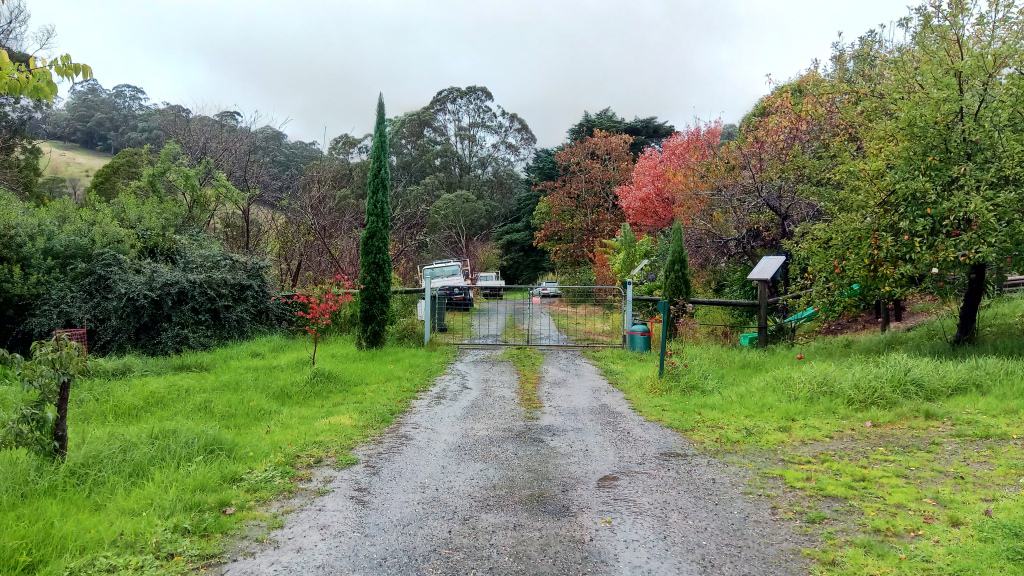
And follows (to the left of the above photo) along the fence line to where the road crosses the creek. Over the years we have planted it out with various interesting trees. We are just passing under a Banyalla.
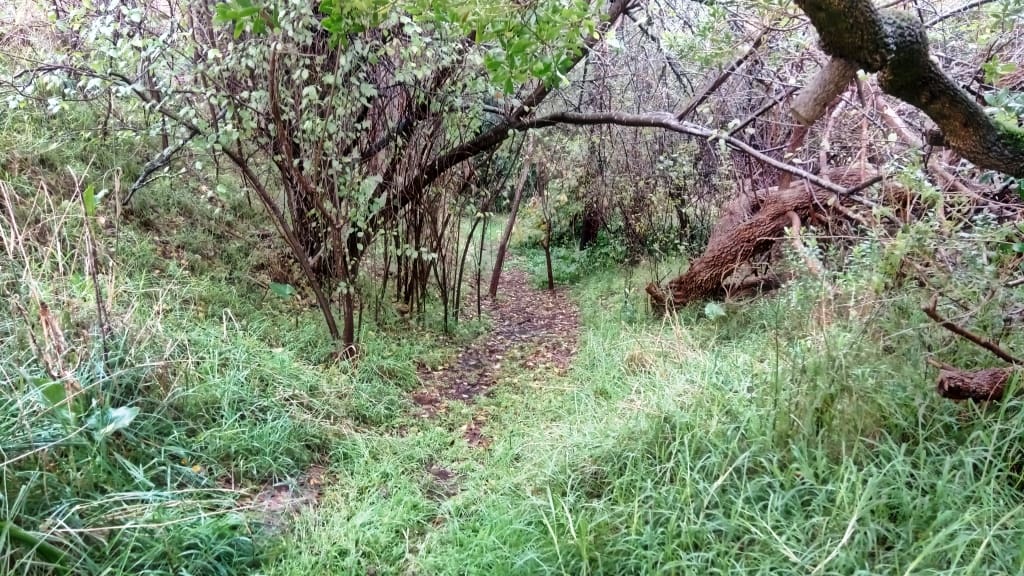
Some of the earlier Blackwoods we planted are still alive but most are at the end of their lives and are being harvested for firewood and replaced. There is an American Wild Black Cherry ahead
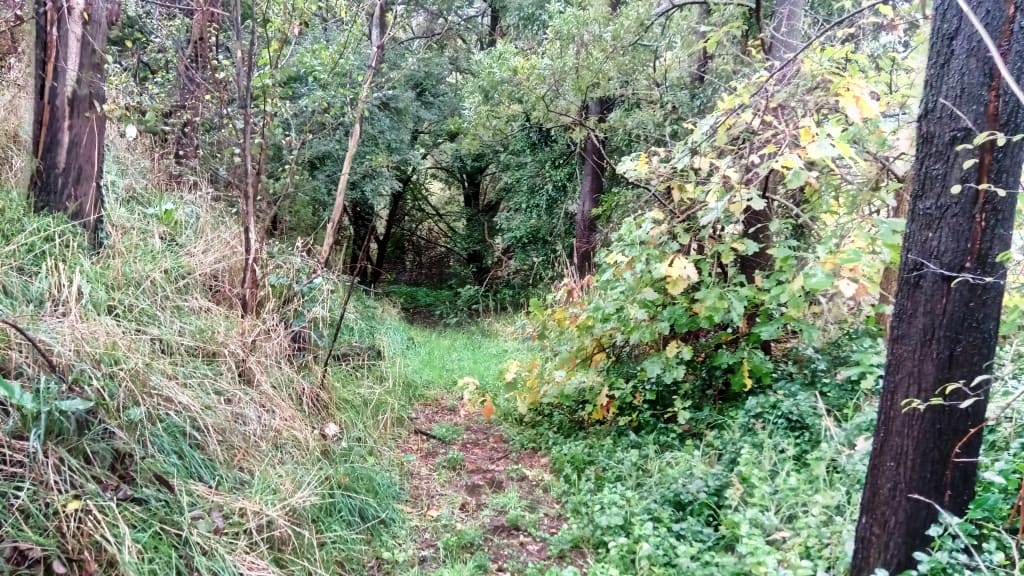
Beautiful Fly Agaric mushrooms love to come up under woodland at this time in autumn. They must under no circumstances be eaten.
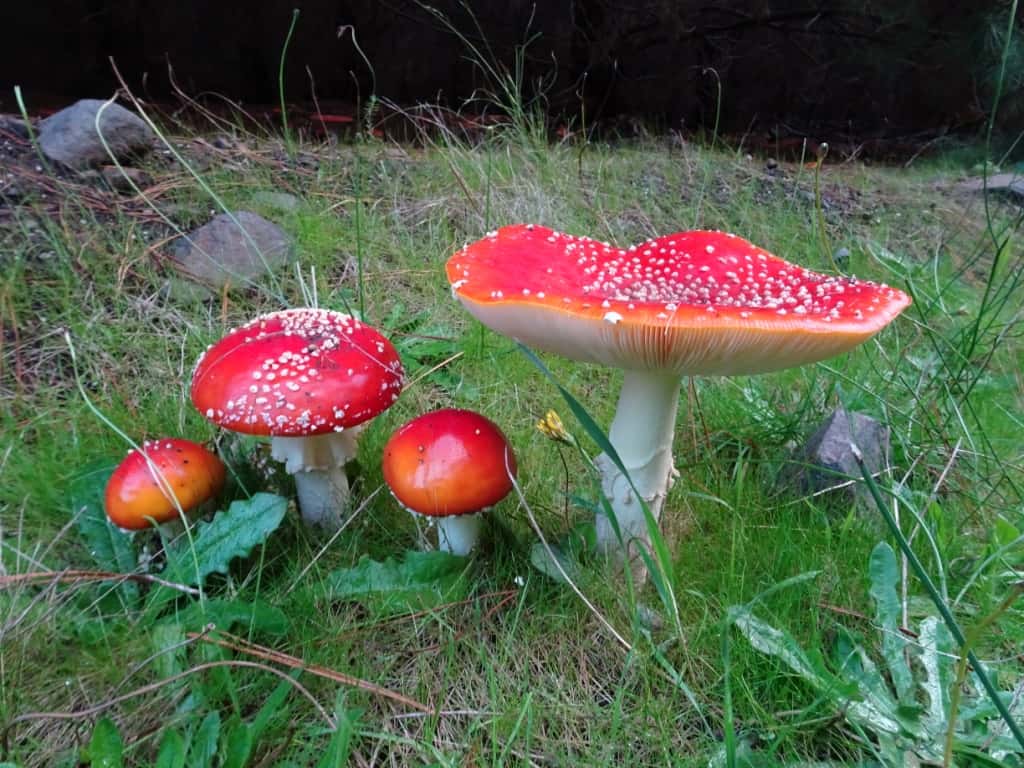
The 4′ concrete pipe under the roadway. bats and swallows love it. When I first came here I could still hear the calls of both creatures, but no more.
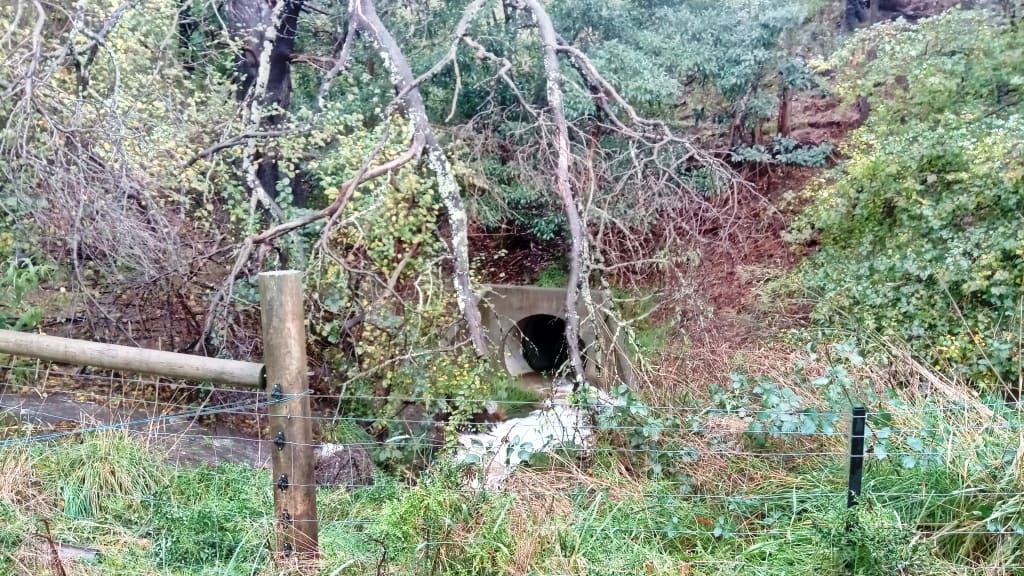
Right where the creek crosses the fence is an evergreen Holly (or Holm) Oak I planted thirty years ago. I have just had to trim some of its lower branches to build the new fence.
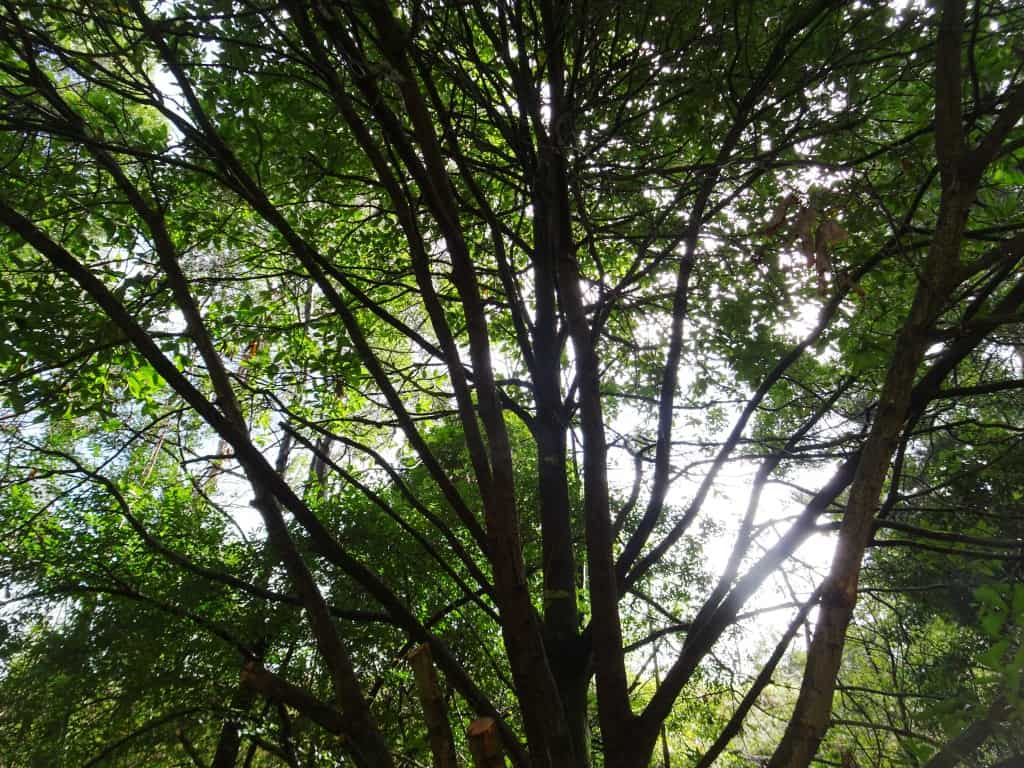
We are currently building new boundary fences all around the farm which will keep all the unwanted wildlife (and especially foxes) out, but will provide a safe habitat for many small creatures and especially birds.
We will reinforce this with nest boxes on strainer units all over the farm for possums, birds and bats. When I am satisfied that I have the foxes at least double fenced out of an area I will re-establish our poultry set-up, and I have been offered some pademelon wallabies too. That would be wonderful. I haven’t seen one of these in the wild since before the myxomatosis epidemic in the 1950s.
I have cleared the first kilometre or so of the path in the forest beyond though it needs more work (particularly blackberry spraying), but also I need to improve the access through the gate in the back corner which is on a particularly steep slope. Quite a lot of digging is needed there to make a safe path, and I might as well add some hand rails too.
The bottom dam looking up the creek. You can see the old Blackwoods have just about finished and new trees are peeking out the tops of the (green) tree guards. For this method of tree planting read this.
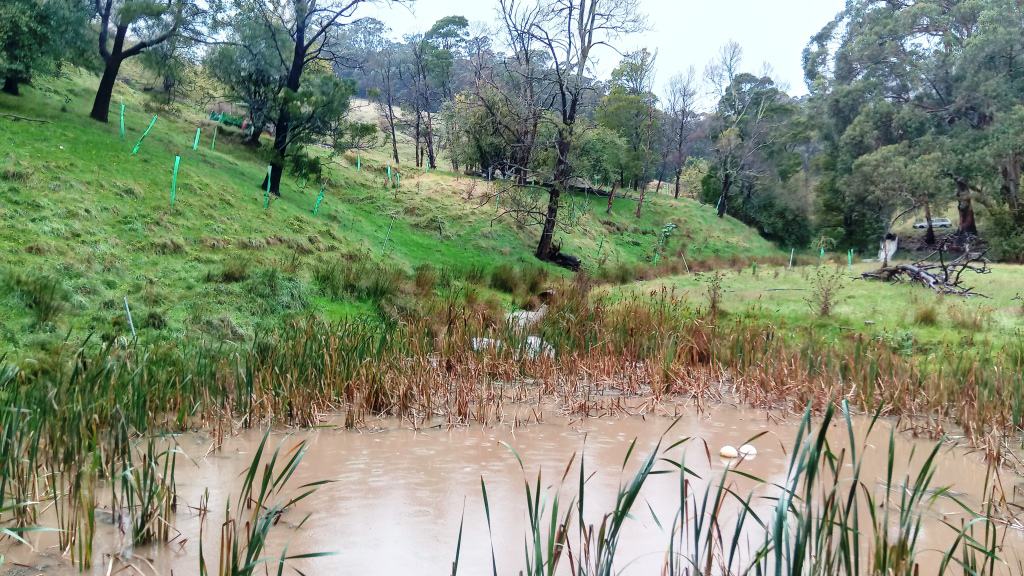
The creek is really foaming as it drops into the lower dam today. We have had the best summer/autumn season in decades here.
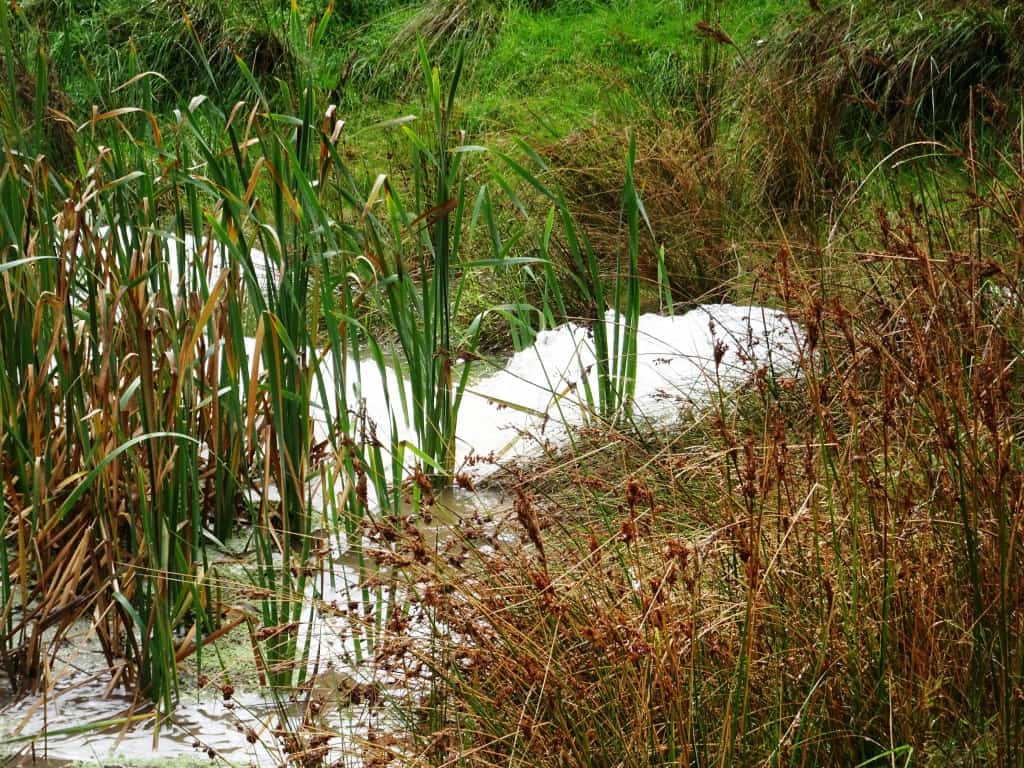
Looking up the creek. You can see where one old (fallen) Blackwood has been harvested for our winter’s fires.
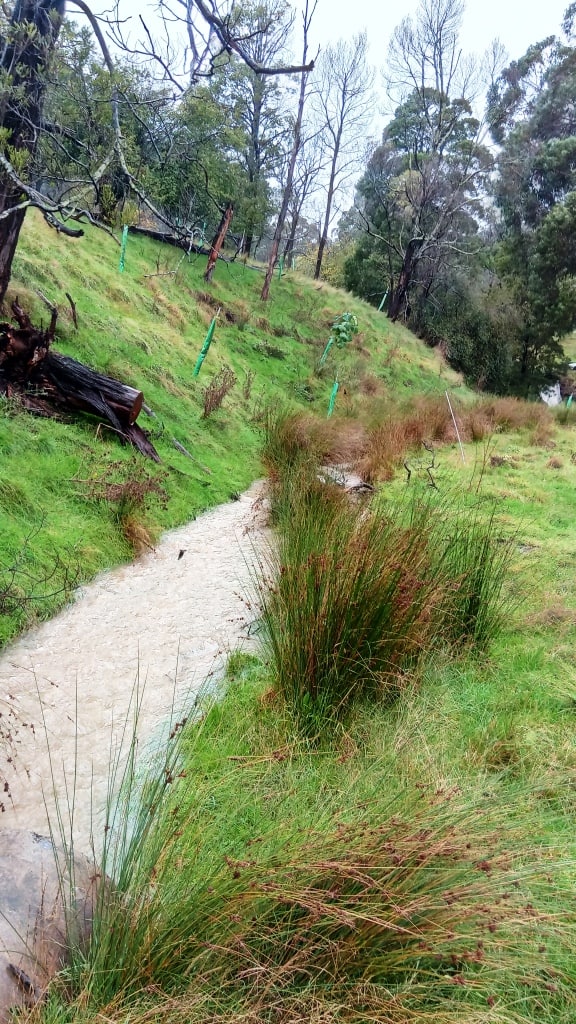
My daughter Merrin’s new tree plantings are shooting out the tops of the tree guards. Some have only been in a year. This is a Paulownia. The tee guards are 5′ tall.
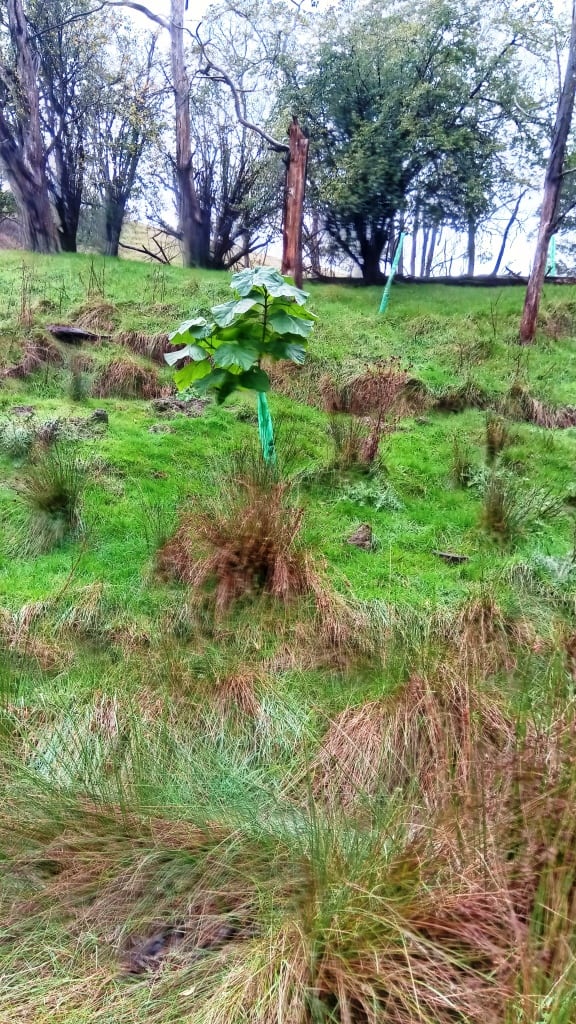
This Weeping Willow will provide lovely summer shade for the stream. It may need a pool under it.
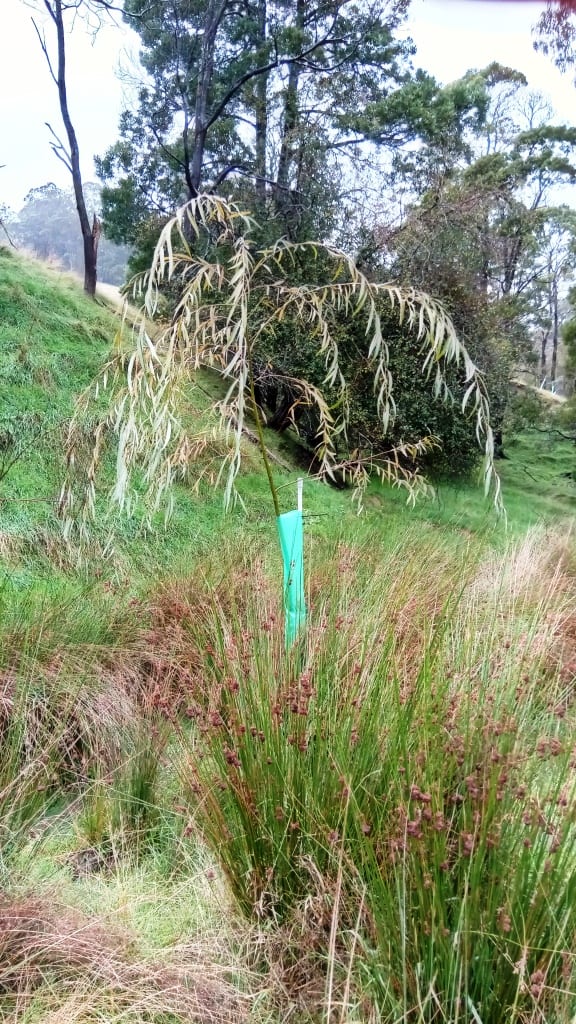
You may remember when we had to construct this spillway under very trying conditions a couple of year’s ago – or lose the dam!
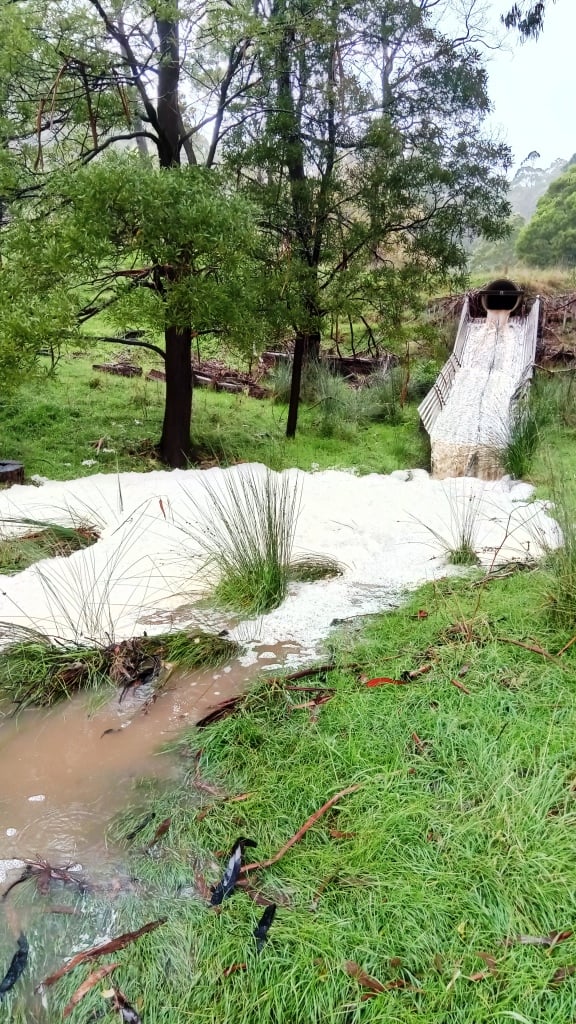
It’s really frothing up this morning. The bubbles are made from natural saponins from tree bark.
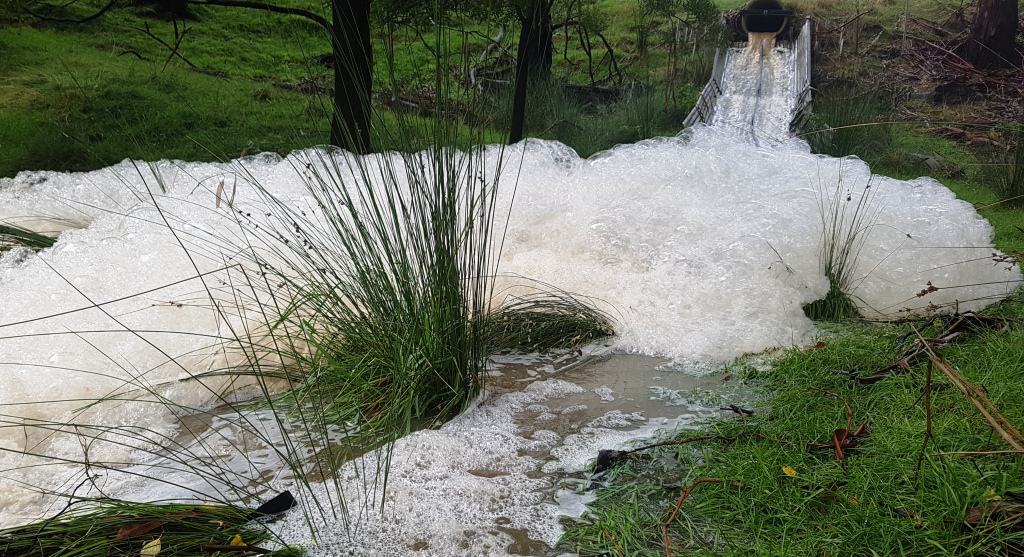
Nearby there is a fine crop of very large field mushrooms which we collected for our (delicious) dinner last night.

Della could not resist a close-up shot.
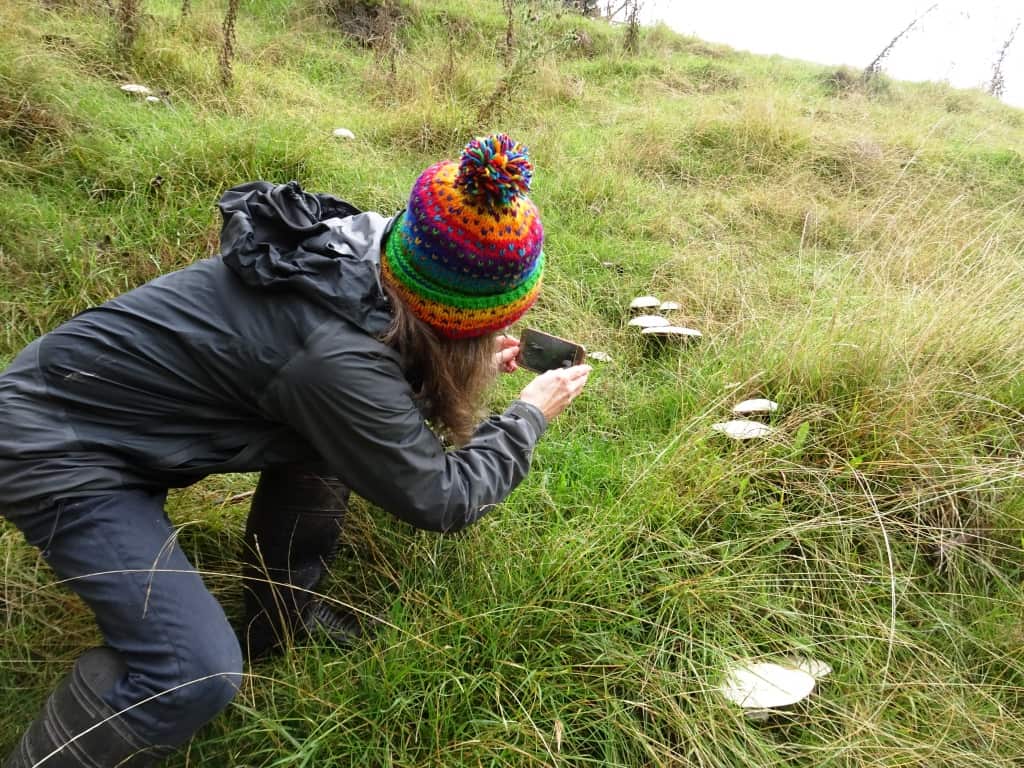
They really were enormous. What a great season for mushrooms.
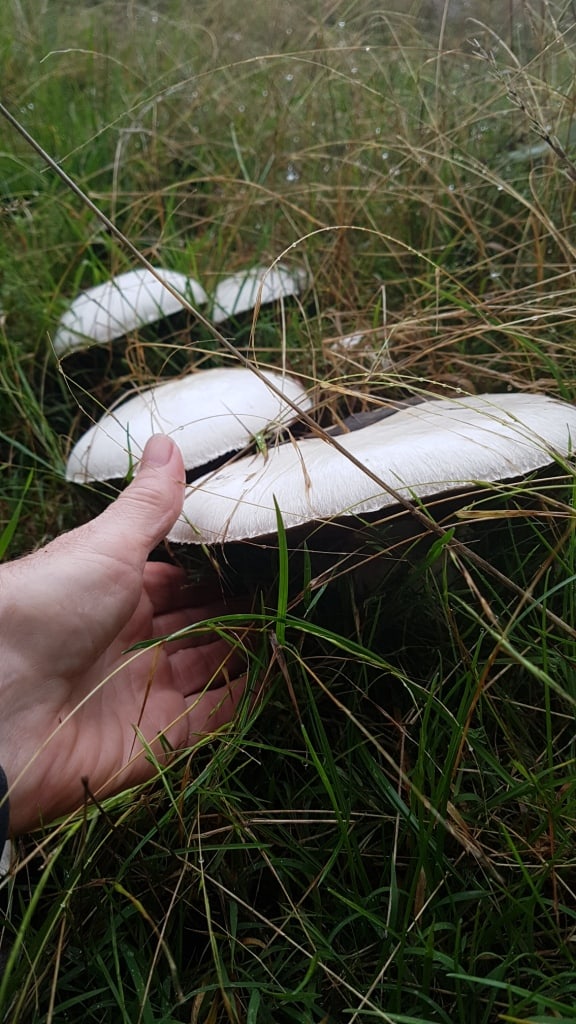
I will make small treated pine sleeper bridges over the stream where you have to cross and recross it, and where it rises up a steep ridge where the stream splits in two I will have to make some steps for the grandchildren Milo and Zoe, currently – and for us old fogies too as we become increasingly feeble.
There is a pretty waterfall in the true right fork of the stream which is currently completely hidden by blackberries. It will be a mighty labour to reveal it once again. The stream there runs year-round so it would be a pity not to harness it. You can never have too much water (supply).
Near the waterfall there are the remains of an old copper/tin mine. I am not quite sure which it was. Mrs Sawyer told me she had recycled the bricks from it which leads over (from our house) to the old two-room cottage where she used to live and raised five children, two of her own and three she inherited from a near relative who had died.
All this without power or even internal plumbing, save for one tap – and until 1968 (when her husband died) not even a telephone. Her parents lived seven miles (and 500 metres elevation) up the mountain. She used to walk up there with children in the pram to visit her – or her mother walked down.
Space was so cramped in her tiny cottage she used to make up stretcher cots for the children each night then fold them up again each morning to make room for breakfast. Yet she regretted ever having had to leave it and here (which i can understand). It was a good life by her accounts. People nowadays expect too much from life.
During the ‘Black Friday” 1939 fire her husband (Harold – her name was Florence) told her to take the children and lock herself in the new galvanized iron tractor shed (with the 44 gallon drum of kerosene!) – which she dutifully did, peeking out now and then to see what was going on.
The fire leapt all the way from the top of the Baw Baws 30-50 km away (to the North-West) onto the top of the Jeeralangs behind us. It was like the sky was on fire. She thought it was the end of the world. Huge flocks of parrots and other birds fleeing the fire ignited in the sky and dropped to the ground roasted.
On the clear Hazelwood Flats to the West of us nearly twenty people were killed by the intensity of the fire and are buried (with a memorial) in the Driffield Cemetery bear the Hazelwood Power Station. In the hills behind dozens were killed, many being boiled alive in stock troughs, water tanks and small dams where they tried to shelter.
As the fire raged all around her at one point she heard a man’s agonised sobbing passing by. She had been told not to come out – and she did not. It turned out not to be her husband (which she first thought) but a neighbour who had sheltered in the dam at the top of our hill (which was nearly dry) and who had tried to pack the wet mud all around himself to stay alive. He saved himself but his back was burned to the bone and he could never work again.
Meanwhile her husband was out in the cleared paddocks beating at the flames with a wet bag. He had tried to drive the cows down to the creek where it was greener but they were caught on the far hill (where the kangaroos are in the photo today) and all their udders were scorched. The dairy also burned down, so Flo and Harold had to tie them to one of the old blue gums to milk them – which was a horror for the next weeks as their udders healed. ‘Thank Goodness for Friar’s Balsam’, she said.
It was a hard life, but there was a buggy ride to Sunday Church meetings at Yinnar South and weekly dances at the Jeeralang North Hall – and many friends and relatives all around, and the joys of raising all those children. Harold’s people had been the original settlers on this property – and Florence has given me copies of old photos of what it used to look like in her time. I will post them on another occasion.
Did her mother survive? Her father was off somewhere working and he did. As the fire approached the woman who lived next door to Flos’ mother on the very top of the Jeeralangs came rushing over in terror for her life. Her Mum grabbed up from the buggy a quilt she had made and led them both to a spring nearby the house which they lay in with the quilt pulled over them while the fire raged over them.
When it was past the house was just ash. The buggy and buggy shed – all the buildings were no more.The water had all boiled from the water tank and its brass tap had melted flat on the ground with the intensity of the fire. There was only one unburnt square left of the quilt – but both women had survived. Flo remade the quilt from that one remaining square and it remains a family heirloom.
Her parents had taken up their property around 1914 and worked hard at it for 25 years. They had no insurance so after the fire they had just to walk away from it and go to Melbourne to find work. Her lengthy weekly visits with her mum were at an end. Yet she felt she had had ‘a fortunate life’.
Climbing the dam bank.

The top dam – or Lake Milo, our grandson’s favourite spot on the farm. There are eels and turtles in the dams.
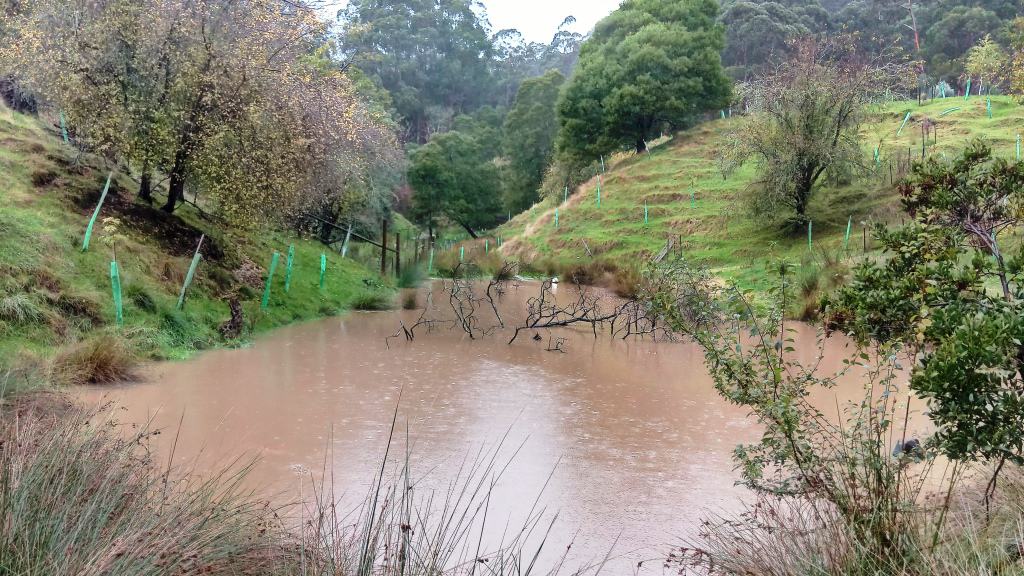
The wood ducks like it too.
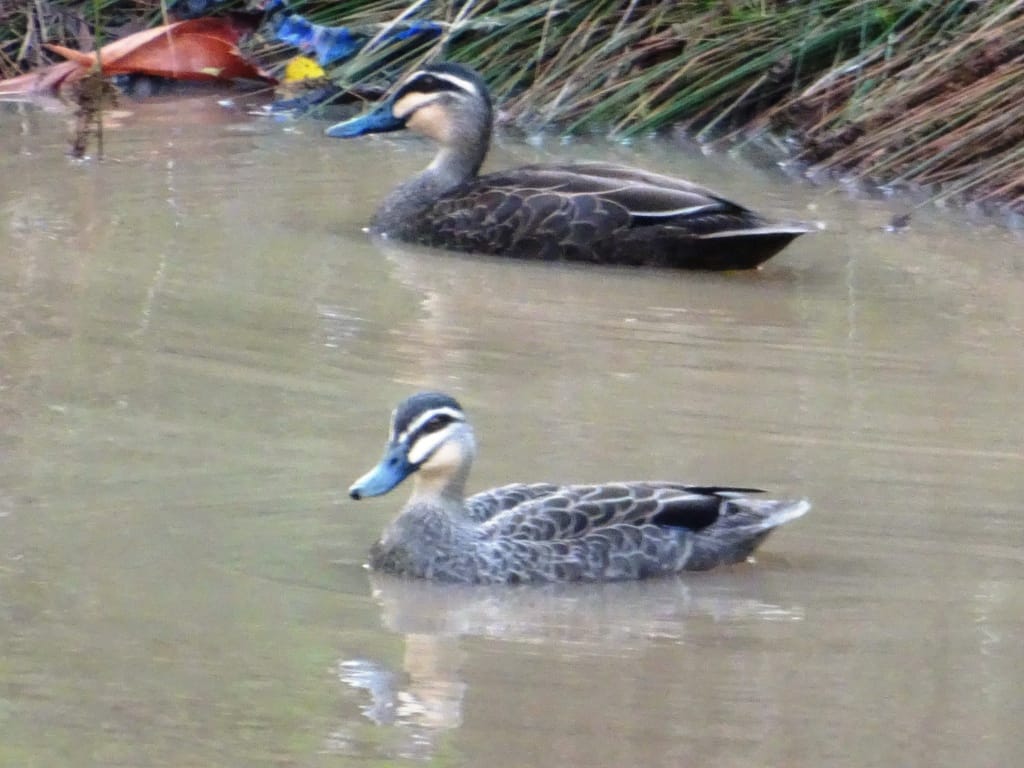
View back down the creek. There are often koalas in these old blue gums.
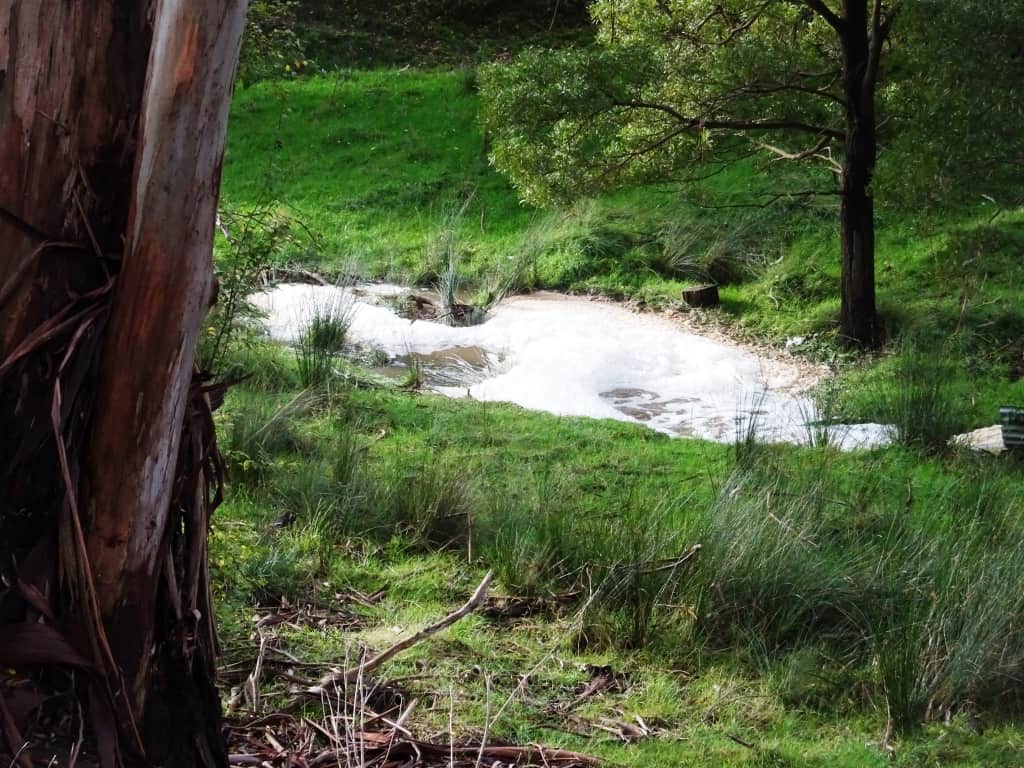
Western grey kangaroos on the hillsides. One of the chief reasons we are building wildlife-proof fences. They are breeding up alarmingly and will eat out all the feed in everyone’s paddocks soon. There is plenty of feed in their own bush, but they prefer ours. We will be making elevated ‘bridges’ for koalas and possums to get in.
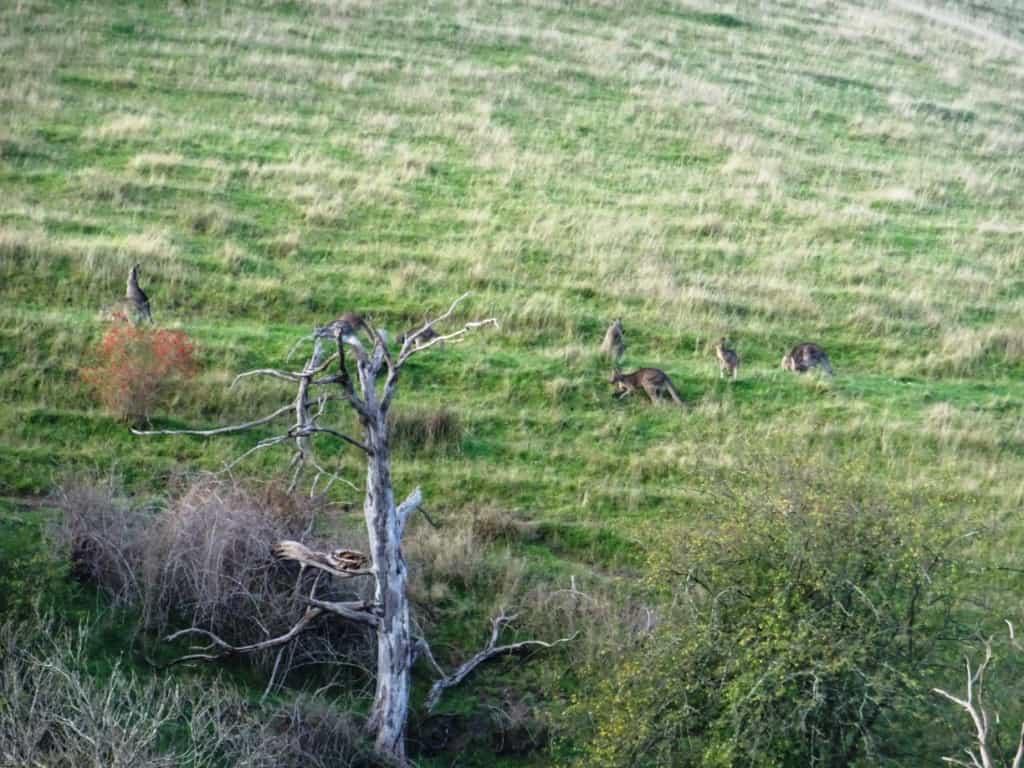
View up the creek past Lake Milo.
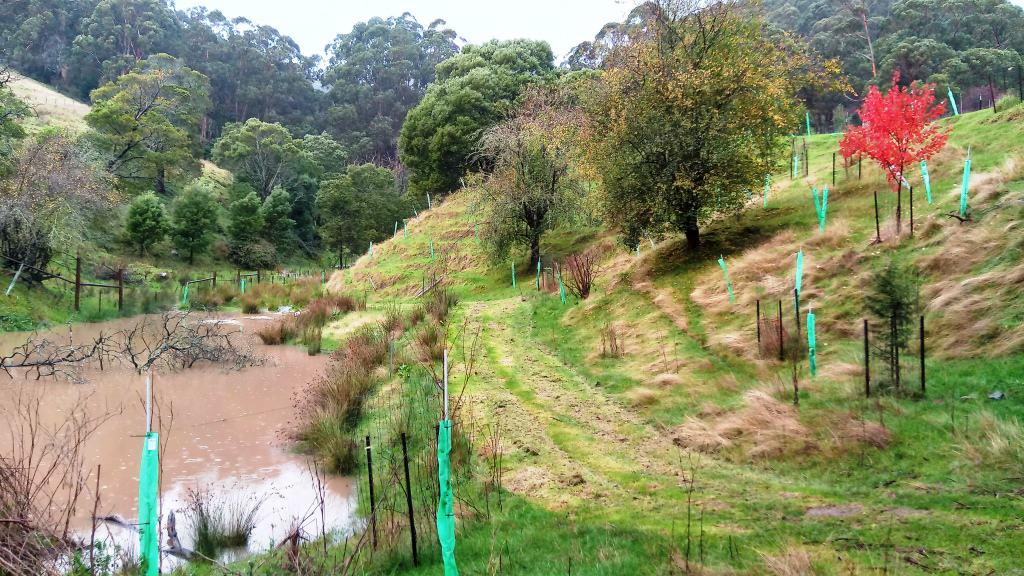
One of Merrin’s Japanese Maples is putting on a fine display – which the sheep seem to appreciate too.
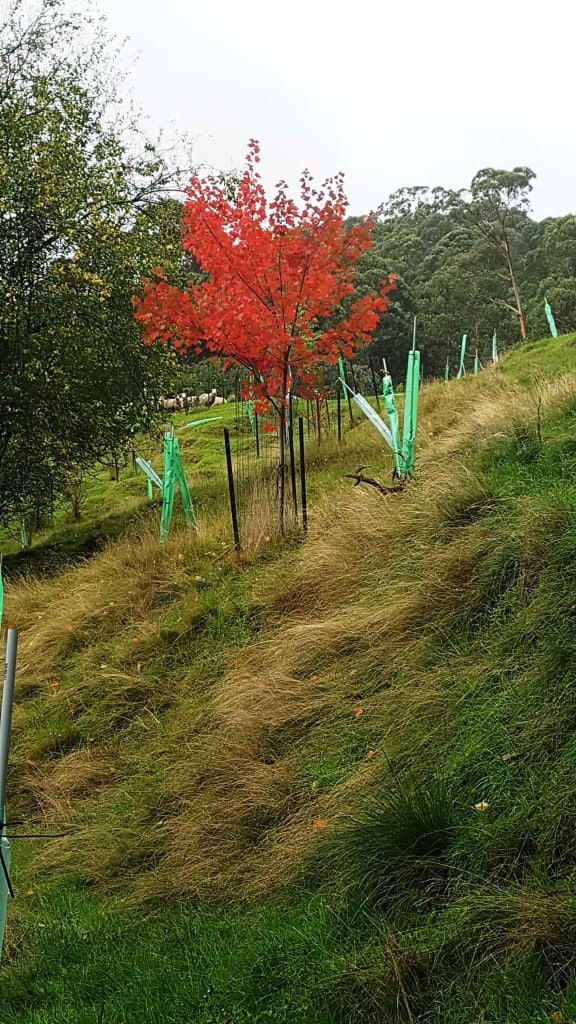
Later they were sheltering under one of the 1912 Monterey Cypresses from the rain.
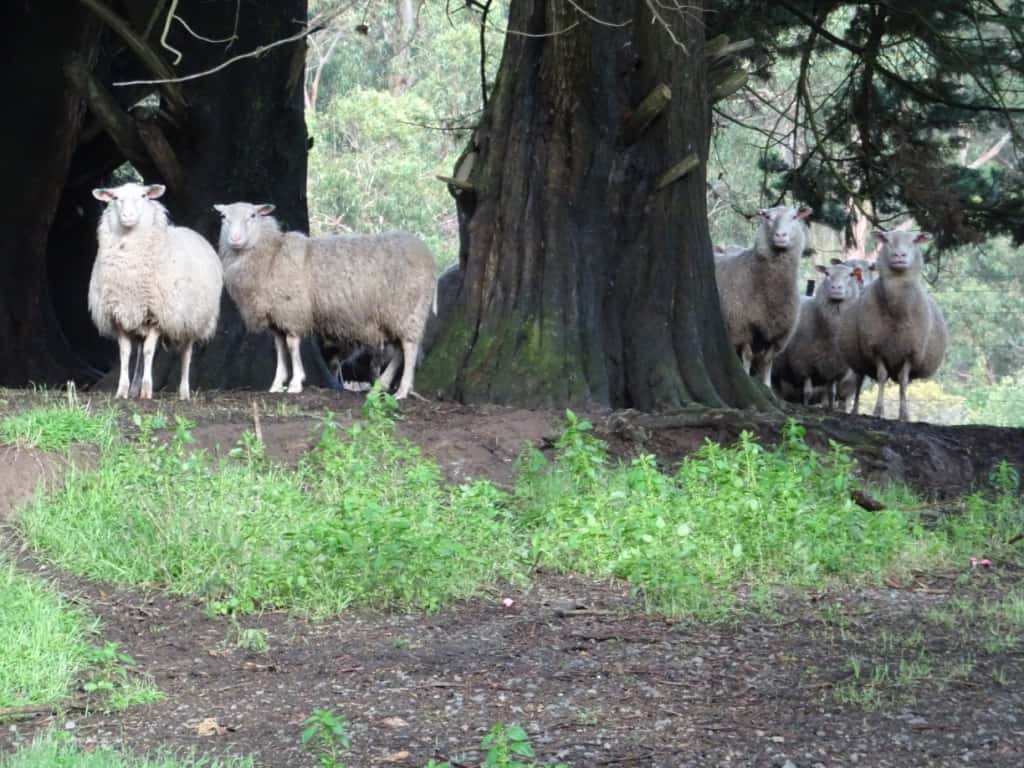
Somewhere in the side of the valley near the tin/copper mine there used to be an adit ie a horizontal shaft intended to open up a black coal mine. This coal was destined for the lime kilns (on the W2 Track) North of Tyers and it was intended would power all Victoria’s railways.
The road which leads from Hazelwood (renamed Churchill on the great man’s death in 1963) to Midvalley is called ‘Tramway Road’ on account of the coal which was to pass along it from up our creek to supply all those needs. As it turned out the contract to supply black coal went to the mine in Wonthaggi so this adit and the coal resource was never developed. I would like to rediscover it sometime though, as fuel is always handy to have at hand when the cold creeps in. I do have a lithograph given to me by a neighbour illustrating it somewhere.
The dogs lead the way. We might not get far today as the creek is ‘running a banker’.
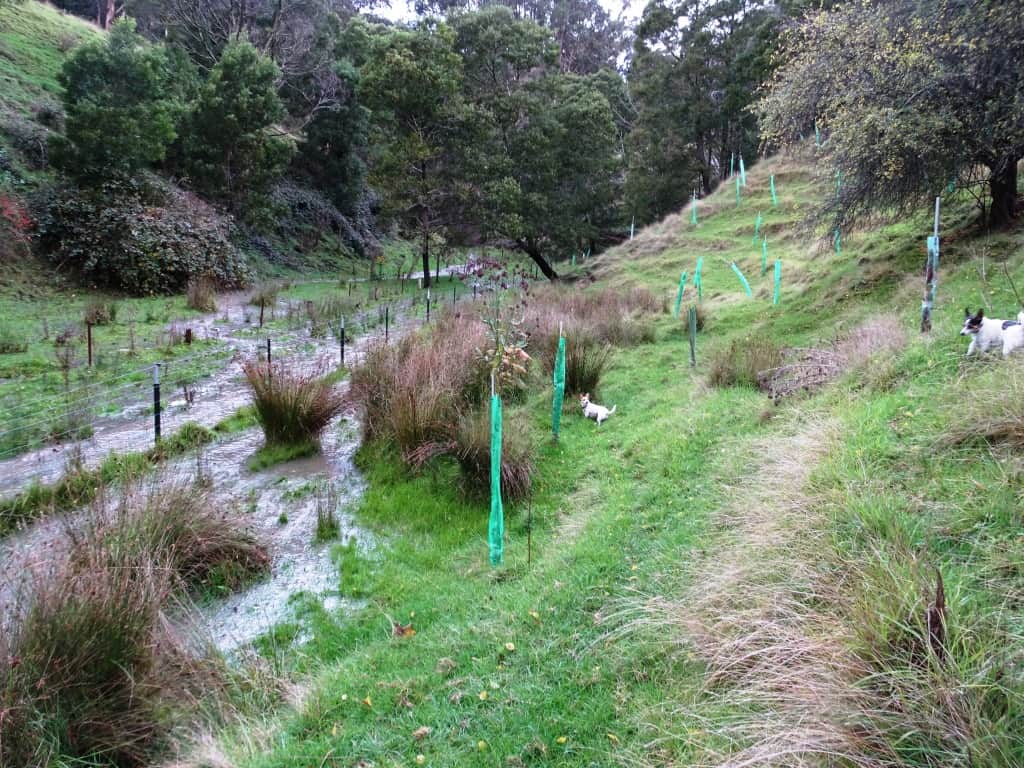
Everywhere there is wildlife. Here an Eastern Scrub Wren.
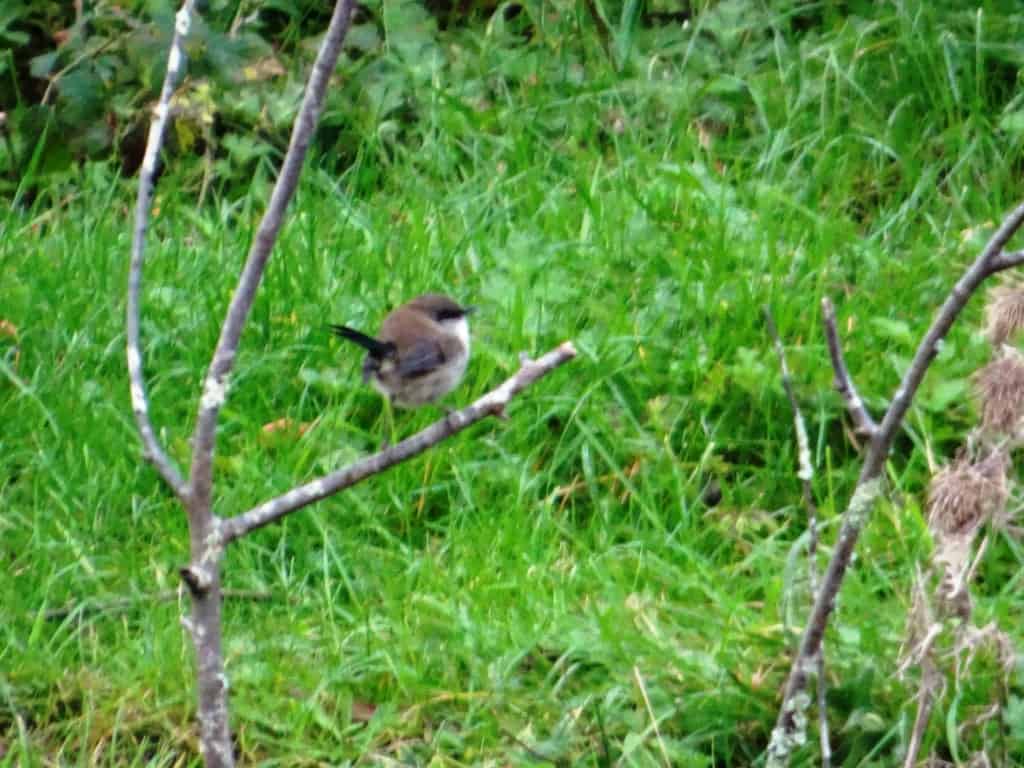
More Grey Kangaroos. Sometimes you will see a deer here too. And of course lots of wombats and swamp wallabies – and innumerable foxes!

There is a junction in the creek right at our top boundary. You can see the treated pine timbers we carried up there to build the new path.
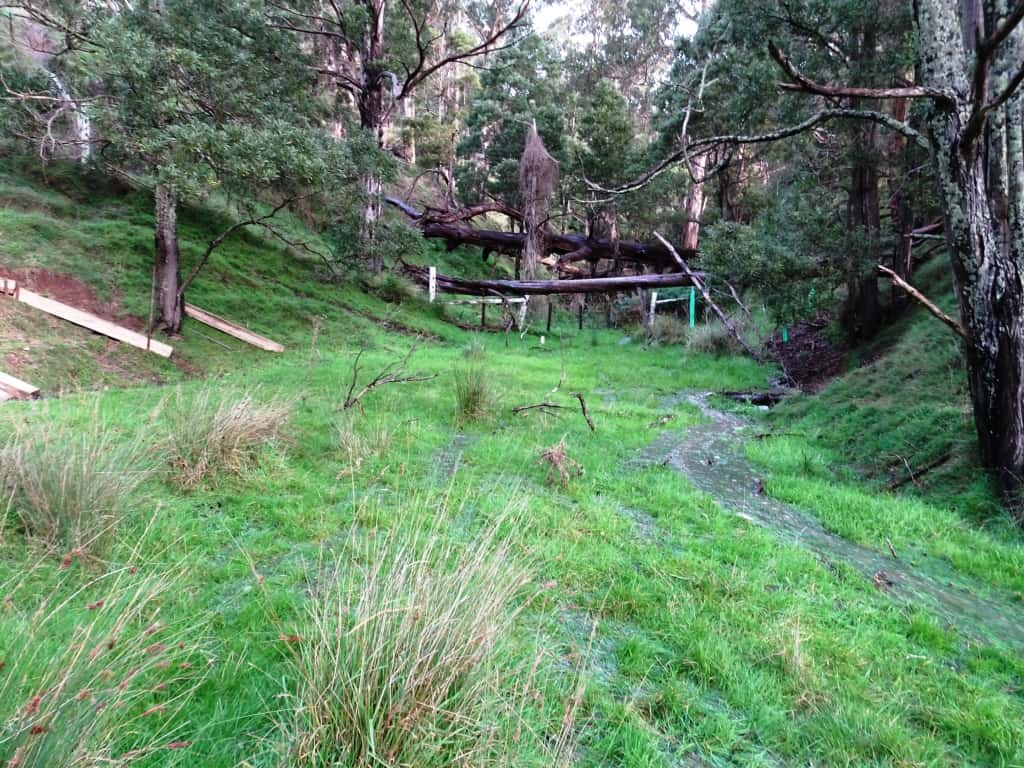
Above the waterfall there is an Wedged Tailed Eagle’s nest high in an ancient blue gum which has been the home of innumerable generations of eagles. They have long feasted on our lambs and those of our predecessors. I bet their nest is completely full of old rabbit traps (and lamb tags) though I am not gong to climb up there to retrieve them as we used to do when we were children, as they (the traps) and rabbits were a valuable thing back then.
My uncle Ken Jones used to go door to door selling ‘skun’ rabbits (the past tense, he claimed of ‘skin’) during the Depression to ‘make a quid’. You have to beware of trying to live solely on rabbit (or wallaby for that matter). Such truly lean meat devoid of fat will not sustain life. People who had nothing else to eat except rabbit used to fall sick, ‘the rabbit sickness’ they used to call it – and could even die. You have to have enough fat in your diet for good health.
The couple of thousand acres of the valley behind us is a near-continuous forest now, but when Mrs Sawyer left here (in 1984) she took a photo looking up the valley from the back verandah of her cottage which she gave me a copy of. Then the land behind was a large sheep grazing property named Braeside and there was merely a scattering of very old blue gums perhaps 1-2 per acre in its entire area.
Still some work top do on it yet.
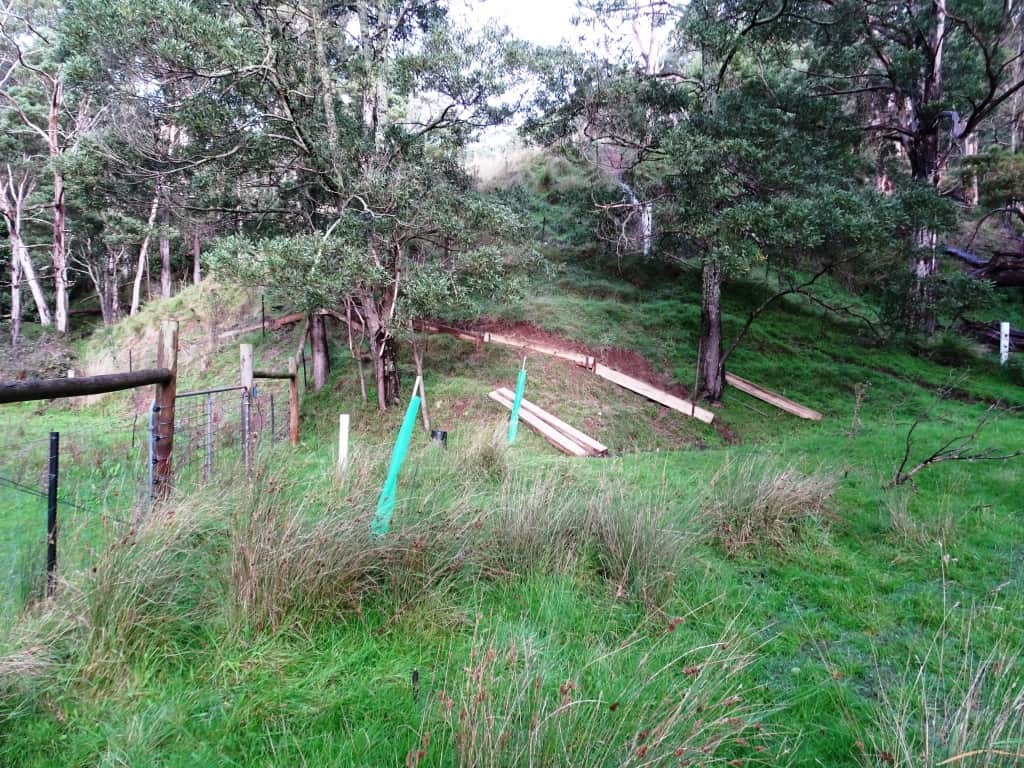
But it is already serviceable.
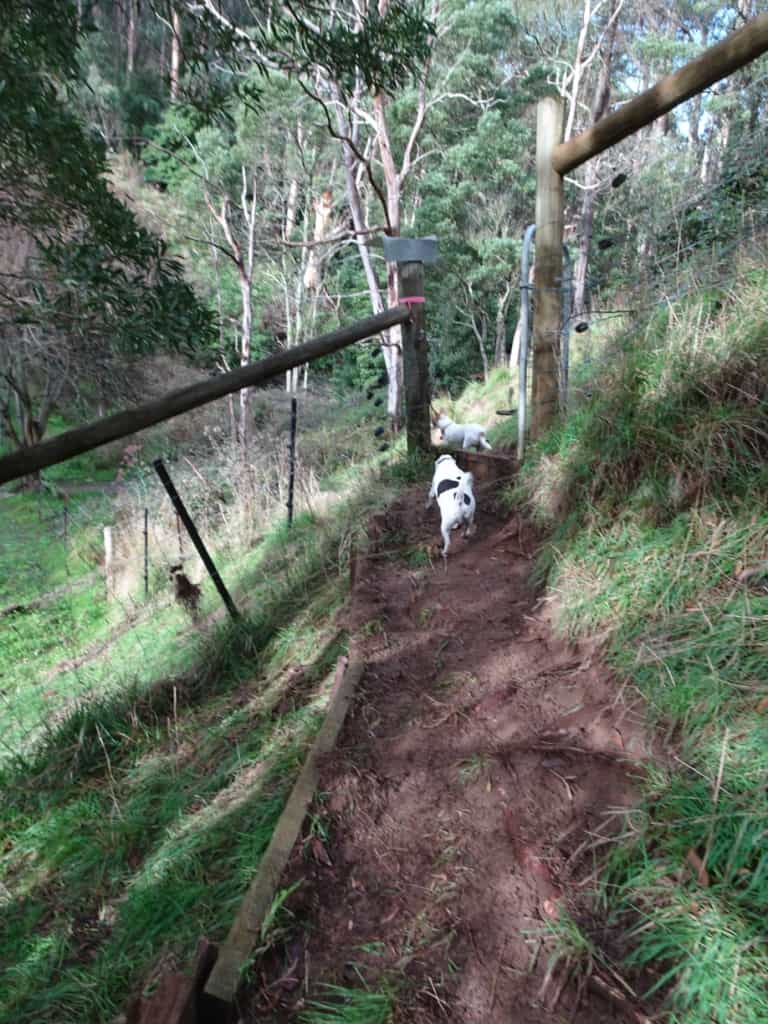
View back down the creek.
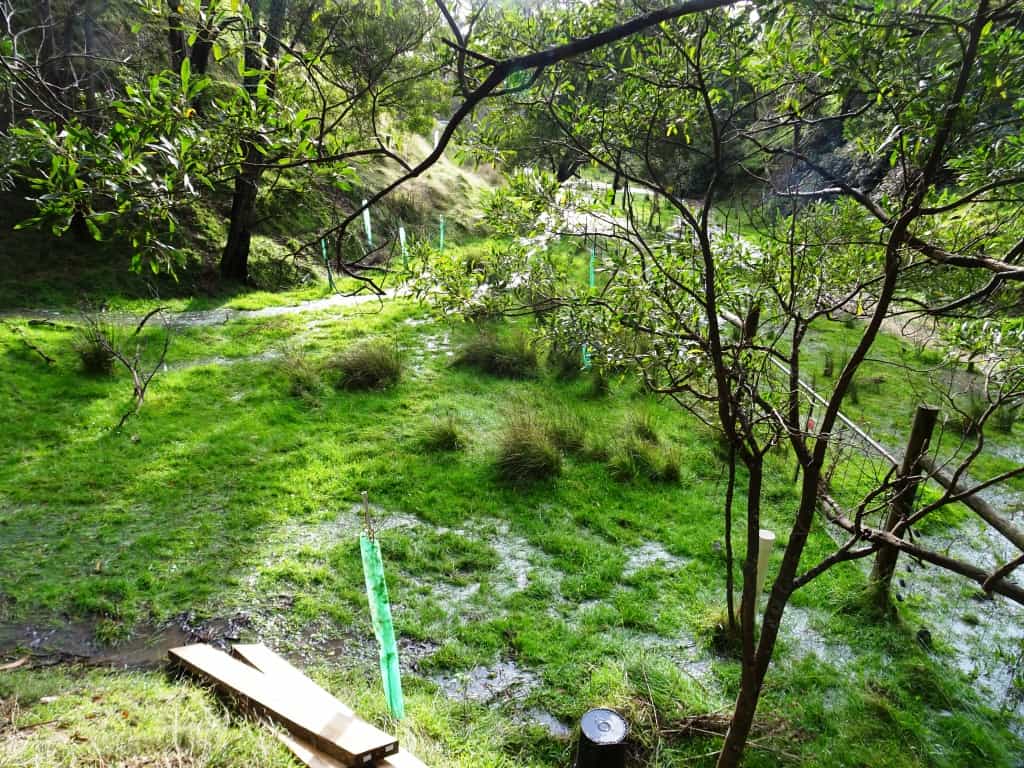
And I have even started on the downhill section. Lots of brush cutting of blackberries ahead (and in Spring spraying the dratted things. They are not on or land.
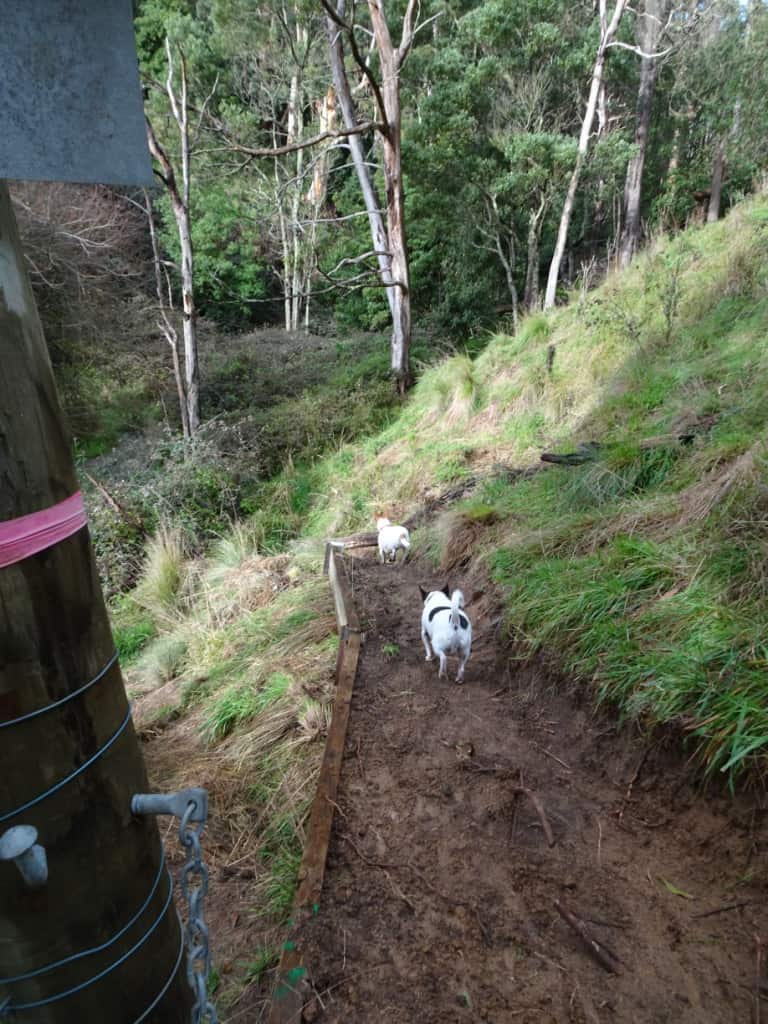
Once through the (first) blackberries the valley looks more promising.
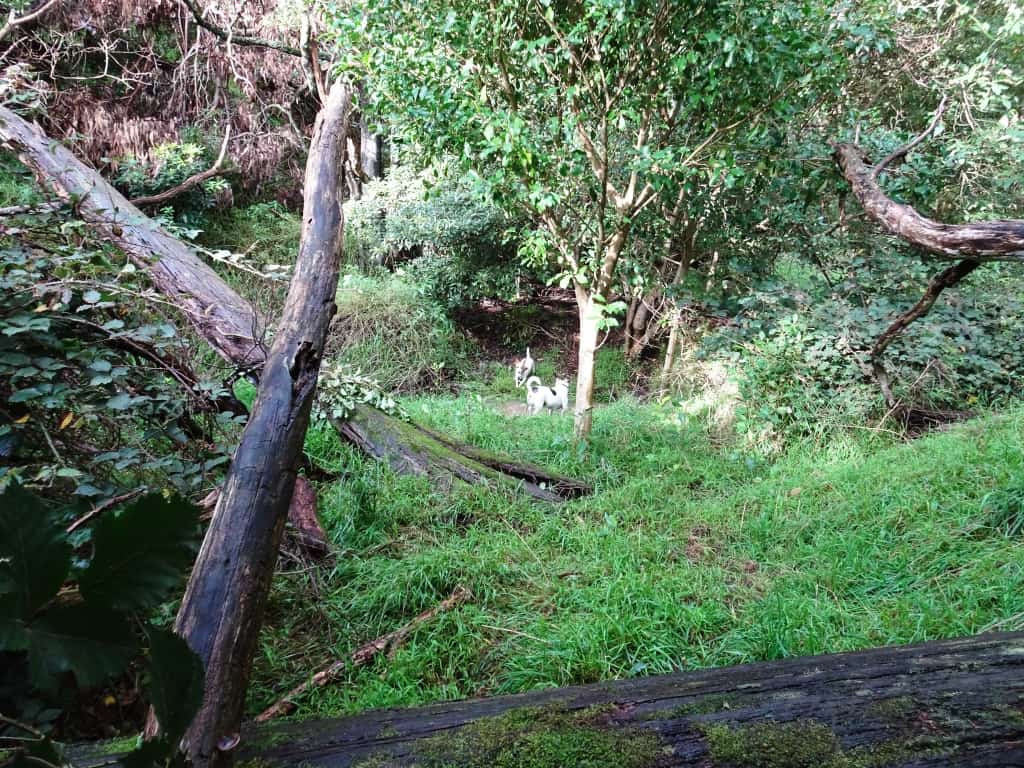
Though there is a fair bit of water in the creek today. These trees are Pittosporum, a favourite of sambar deer.
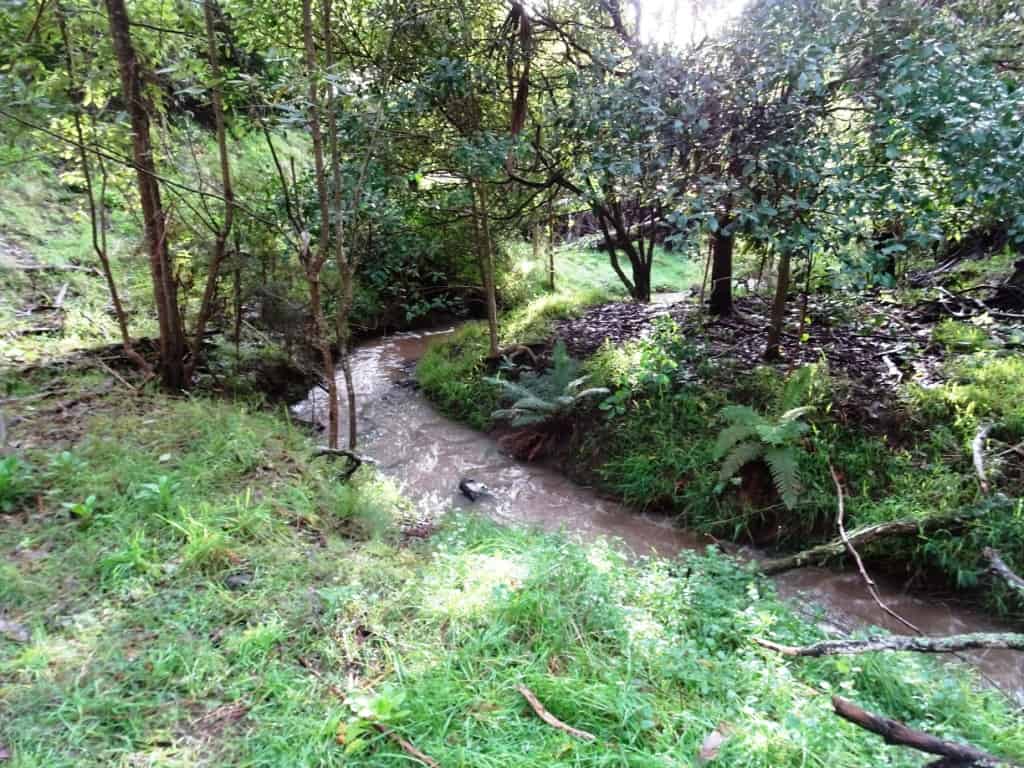
We may come up here next week and camp to try the new tent out. See what I mean about the kangaroos having plenty of feed in their own bush?
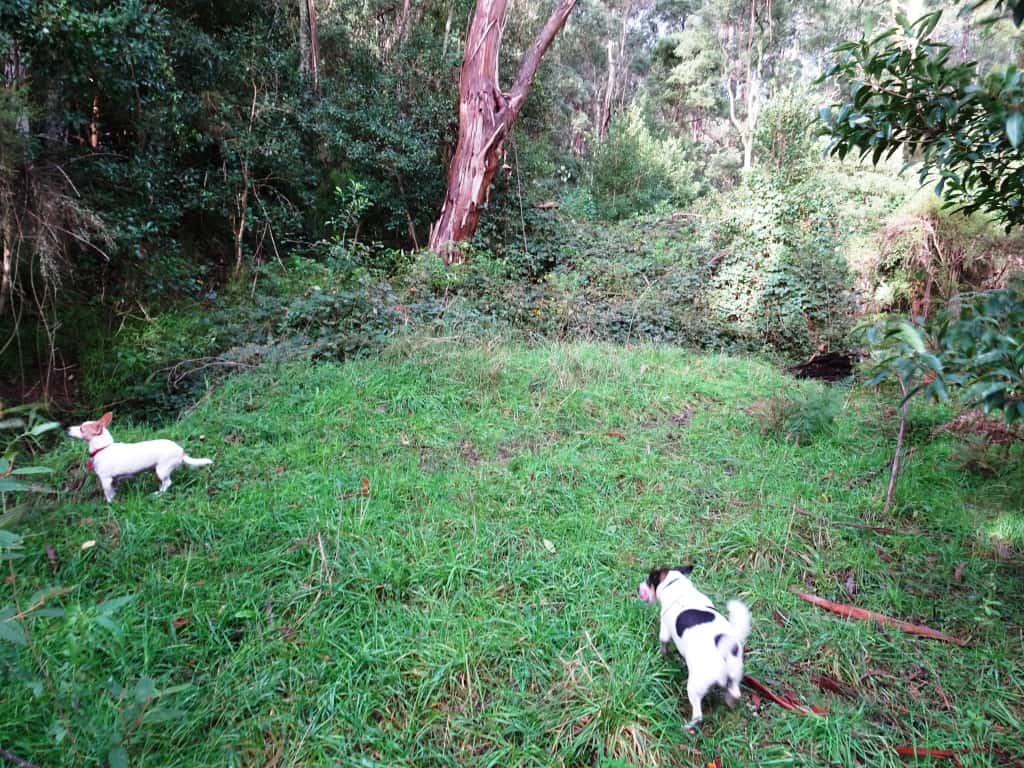
‘The road leads ever on and on’ – as Bilbo says, but this morning our way is blocked by floodwater unless we want to wade. We don’t. That water is cold today. The air is only 10C – unusually cold for early May.
It was the coldest 1st May on record they say, though I reckon I can recall a colder one when I was about ten and had to swim out on an icy flooded pond in just such a creek to retrieve a water rat and trap. Their fur was the most expensive and sought after – long after it was no longer legal to take them. The Myxomatosis (rabbit eradication) programme spelt the end for them (as so much wildlife: pademelons, antechinus, bandecoots, quolls etc) as there was suddenly nothing else for foxes and cats to eat. Hence our wildlife or fox-proof fences. There are still antechinus and bandecoots around, though the wombats and roos eat all their vegetation and the foxes eat them. I hope to see them come back inside our fences where they will be able to get.
We will complete the tour another day – and in another post.
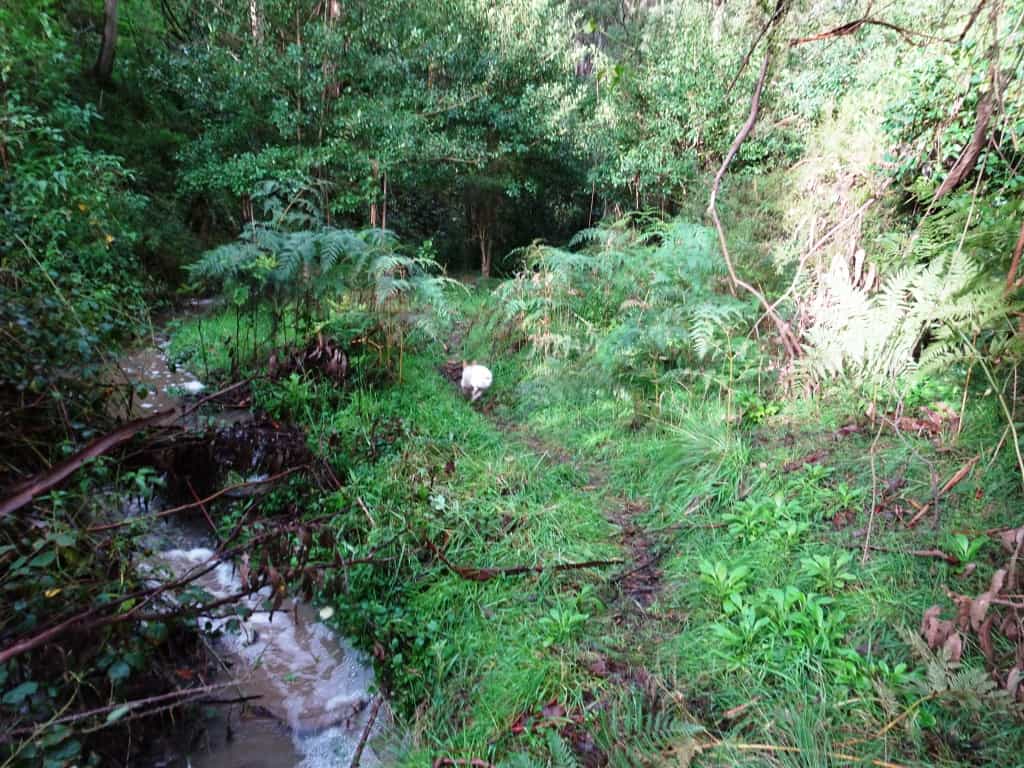
Just a couple of last snaps. Some interesting Bracket Fungi. These guys can be dried as fire starters.
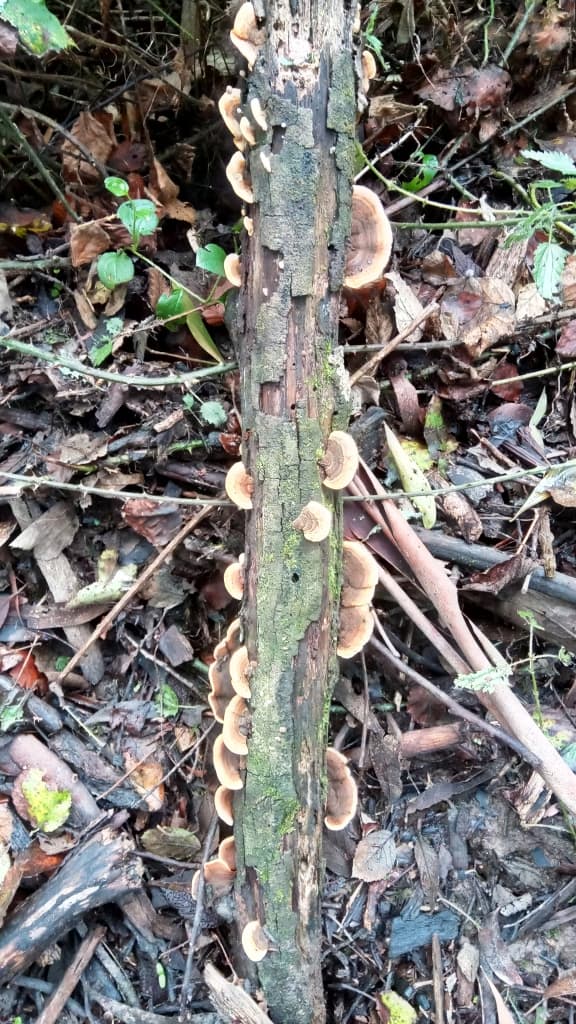
And a young Eastern Rosella.
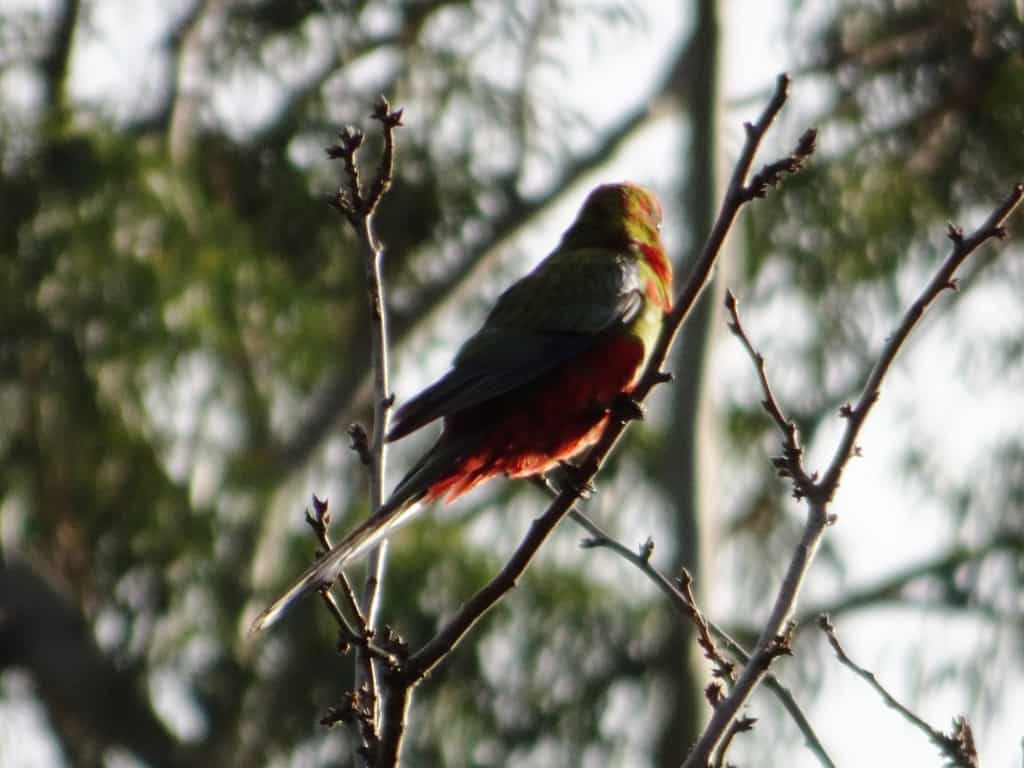
People are deluded in their belief that during their lifetime mankind has been deforesting the country. The high (or low) point of that land clearance is now a long time ago, before the depression anyway. Since the second World War more and more cleared land has been let ‘go back’ to bush – whether that is a good thing or not.
My father’s other brother, Basil retired around 1985 to Barrington North of Newcastle. We visited him there a number of times before his early death (at 70) in 1990. He gor me started in whitewater canoeing on the Barrington River nearby. I had not been in that area (until then) for many years, basically not since my childhood.
During Governor Macquarie’s time (c1815) the area around There was granted to the AA Company as a large sheep grazing property (100,000 acres) as it was found to be clear land on European settlement. Most of Australia was back then. There is much more forest now!
After a few years the company petitioned the government to give up that land and have instead land near Tamworth at Goonoo Goonoo as they found the sheep became ill-thrifty because of copper deficiency. They are still there today.
The land around Barrington, the Upper Williams River etc was abandoned for more than a century and grew back to forest. After the Second World War returned servicemen were granted a ‘Soldier Settlement Block’ there of 320 acres each providing they cleared the land – which they did by ring-barking.
When I was a child I can remember the vast ring-barked properties there where we visited my father’s mates who had taken up dairy farming – as he had. The stumps were eventually burned out and the paddocks resembled a cratered field, like a green moonscape. Lots of kids of my generation grew up on such hard-scrabble dairy farms, as I did.
When Britain joined the EU in 1968 Australia’s market for all that dairy produce evaporated overnight. Everyone had to just walk off their hard-won properties and go to the cities for work.
By the time I visited Basil there in the late 1980s the area was once again forest. It was a forest considered so ‘pristine’ by the emerald brother and sisterhood that it was made into the Barrington National Park. Yet I can remember in my own lifetime its being a forest before, then cleared land and once again a forest. Pristine indeed!
All the land behind our property here at Jeeralang had just that same history as Barrington. It was all cleared at Soldier Settlement Blocks and used for dairying (until 1968). Some struggled on sheep farming, as in the valley behind but in the absence of being able to afford superphosphate and with falling wool prices etc, this too was abandoned and the land is now a continuous forest for a hundred kilometres right behind us!
A Million Wild Acres by Eric Rolls opened my eyes to the nature of so-called ‘land clearance’ in this country. Of course I had noticed the sort of landscapes depicted by those early colonial painters Thomas Watling and etc. The largely open cleared nature of the country depicted, but it was not until i read Rolls’ book and its account of the Pillaga that the penny really dropped for me. He made the point that Blaxland, Lawson and Wenworth’s path over the Blue Mountains could be followed by bushwalkers today (as it was meant to be). They made diary entries every 15 minutes noting what could be seen. Pretty much always no or few trees in what is now the heavily forested (and burnt!) Blue Moutains National Park. When people arrived at the Pillaga ( where my parents used to take our bees every year when I was a child – now NSW’s biggest national park – one million aces, and hence the title) there was only about one tree per acre (mostly native pine) and lots of rat-kangaroos. The land was taken up for grazing and presumably he sheep and shepherd’s dogs did for the rat kangaroos which had been preventing trees from emerging. Shortly afterwards a drought came along as such things are wont to do in Australia and the settlers were forced to retreat to the Dimby Downs near Tamworth for seven years. When they returned the forest was there and despite a hundred years of systematic efforts to clear it, it remains!
For an aerial view of our property, see this post: Drone Hunting.
See Also:
https://www.theultralighthiker.com/2016/07/22/a-dam-nuisance/
https://www.theultralighthiker.com/2019/10/16/trees-and-tree-guards/
https://www.theultralighthiker.com/2018/07/02/several-winters-fires/
https://www.theultralighthiker.com/2020/05/02/fun-with-fungi/
https://www.theultralighthiker.com/2020/04/25/deer-hunters-tent-2/
https://www.theultralighthiker.com/2018/01/26/drone-hunting/
https://www.theultralighthiker.com/2015/11/26/the-buggy-shed/
https://www.theultralighthiker.com/2019/08/17/the-apc-and-the-sponge-bath/
https://www.theultralighthiker.com/2018/06/23/you-must-learn-to-shoot-your-own-dog/
https://www.theultralighthiker.com/2018/06/02/mattresses-i-have-known/
https://www.theultralighthiker.com/2019/07/22/johnny-cakes/
https://www.theultralighthiker.com/2015/09/08/birds-in-our-garden/
https://www.theultralighthiker.com/2018/07/06/wildlife-proof-fencing/
https://www.theultralighthiker.com/2015/07/18/automatic-gate-controllers/
